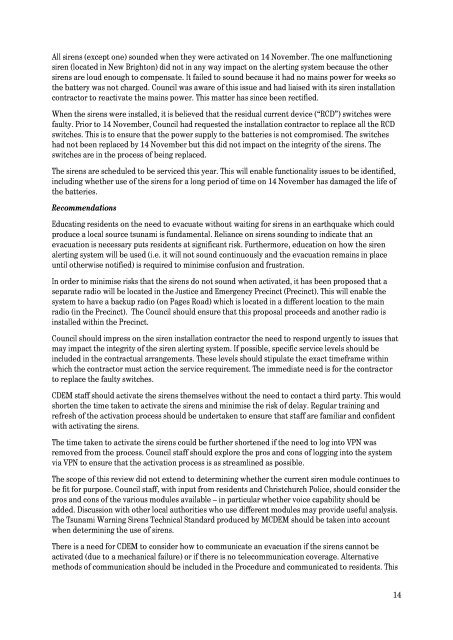Review of the Tsunami Evacuation 2017
Create successful ePaper yourself
Turn your PDF publications into a flip-book with our unique Google optimized e-Paper software.
All sirens (except one) sounded when <strong>the</strong>y were activated on 14 November. The one malfunctioning<br />
siren (located in New Brighton) did not in any way impact on <strong>the</strong> alerting system because <strong>the</strong> o<strong>the</strong>r<br />
sirens are loud enough to compensate. It failed to sound because it had no mains power for weeks so<br />
<strong>the</strong> battery was not charged. Council was aware <strong>of</strong> this issue and had liaised with its siren installation<br />
contractor to reactivate <strong>the</strong> mains power. This matter has since been rectified.<br />
When <strong>the</strong> sirens were installed, it is believed that <strong>the</strong> residual current device (“RCD”) switches were<br />
faulty. Prior to 14 November, Council had requested <strong>the</strong> installation contractor to replace all <strong>the</strong> RCD<br />
switches. This is to ensure that <strong>the</strong> power supply to <strong>the</strong> batteries is not compromised. The switches<br />
had not been replaced by 14 November but this did not impact on <strong>the</strong> integrity <strong>of</strong> <strong>the</strong> sirens. The<br />
switches are in <strong>the</strong> process <strong>of</strong> being replaced.<br />
The sirens are scheduled to be serviced this year. This will enable functionality issues to be identified,<br />
including whe<strong>the</strong>r use <strong>of</strong> <strong>the</strong> sirens for a long period <strong>of</strong> time on 14 November has damaged <strong>the</strong> life <strong>of</strong><br />
<strong>the</strong> batteries.<br />
Recommendations<br />
Educating residents on <strong>the</strong> need to evacuate without waiting for sirens in an earthquake which could<br />
produce a local source tsunami is fundamental. Reliance on sirens sounding to indicate that an<br />
evacuation is necessary puts residents at significant risk. Fur<strong>the</strong>rmore, education on how <strong>the</strong> siren<br />
alerting system will be used (i.e. it will not sound continuously and <strong>the</strong> evacuation remains in place<br />
until o<strong>the</strong>rwise notified) is required to minimise confusion and frustration.<br />
In order to minimise risks that <strong>the</strong> sirens do not sound when activated, it has been proposed that a<br />
separate radio will be located in <strong>the</strong> Justice and Emergency Precinct (Precinct). This will enable <strong>the</strong><br />
system to have a backup radio (on Pages Road) which is located in a different location to <strong>the</strong> main<br />
radio (in <strong>the</strong> Precinct). The Council should ensure that this proposal proceeds and ano<strong>the</strong>r radio is<br />
installed within <strong>the</strong> Precinct.<br />
Council should impress on <strong>the</strong> siren installation contractor <strong>the</strong> need to respond urgently to issues that<br />
may impact <strong>the</strong> integrity <strong>of</strong> <strong>the</strong> siren alerting system. If possible, specific service levels should be<br />
included in <strong>the</strong> contractual arrangements. These levels should stipulate <strong>the</strong> exact timeframe within<br />
which <strong>the</strong> contractor must action <strong>the</strong> service requirement. The immediate need is for <strong>the</strong> contractor<br />
to replace <strong>the</strong> faulty switches.<br />
CDEM staff should activate <strong>the</strong> sirens <strong>the</strong>mselves without <strong>the</strong> need to contact a third party. This would<br />
shorten <strong>the</strong> time taken to activate <strong>the</strong> sirens and minimise <strong>the</strong> risk <strong>of</strong> delay. Regular training and<br />
refresh <strong>of</strong> <strong>the</strong> activation process should be undertaken to ensure that staff are familiar and confident<br />
with activating <strong>the</strong> sirens.<br />
The time taken to activate <strong>the</strong> sirens could be fur<strong>the</strong>r shortened if <strong>the</strong> need to log into VPN was<br />
removed from <strong>the</strong> process. Council staff should explore <strong>the</strong> pros and cons <strong>of</strong> logging into <strong>the</strong> system<br />
via VPN to ensure that <strong>the</strong> activation process is as streamlined as possible.<br />
The scope <strong>of</strong> this review did not extend to determining whe<strong>the</strong>r <strong>the</strong> current siren module continues to<br />
be fit for purpose. Council staff, with input from residents and Christchurch Police, should consider <strong>the</strong><br />
pros and cons <strong>of</strong> <strong>the</strong> various modules available – in particular whe<strong>the</strong>r voice capability should be<br />
added. Discussion with o<strong>the</strong>r local authorities who use different modules may provide useful analysis.<br />
The <strong>Tsunami</strong> Warning Sirens Technical Standard produced by MCDEM should be taken into account<br />
when determining <strong>the</strong> use <strong>of</strong> sirens.<br />
There is a need for CDEM to consider how to communicate an evacuation if <strong>the</strong> sirens cannot be<br />
activated (due to a mechanical failure) or if <strong>the</strong>re is no telecommunication coverage. Alternative<br />
methods <strong>of</strong> communication should be included in <strong>the</strong> Procedure and communicated to residents. This<br />
14















